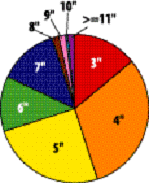Reprinted with permission from Modern Woodworking Magazine.
by Dr. Fred M. Lamb
Today’s smaller diameter tree harvests can impact your yield and part-width distribution. Don’t let what you don’t know hurt you. Have you thought about these considerations?
For several years now, I have been talking about how more and more of today’s lumber is coming from smaller diameter, younger trees growing on poorer sites. One impact of the smaller diameter part of that description is narrower boards. What do narrower boards mean in terms of rough mill yield? How does an increasingly narrower board width distribution impact both yield and the required part-width distribution?
Consider this: When ripping solids of 21/4" in width, how many such strips can be produced from a rough, dry board 5.0" wide? Under most conditions and most rough mill configurations, only one 21/4" strip could be ripped. A strip of narrower width could be salvaged, but not a second 21/4" inch strip. In general, board width distribution impacts gang-rip-first configurations to a greater degree than the other rough mill set-ups. However, cut-and-rip lines and other configurations are not immune to the adverse impact of narrower boards and board width distributions that are skewed to the narrow widths.

Figure 1
Figure 1 shows a board width distribution for 5/4 red oak Number 1 Common lumber. The data were collected several years ago at several rough mills in the Virginia and North Carolina area. These data are not meant to imply any national averages or such. They are what they are: the board width distribution that occurred at several operations at a particular time. They do, however, clearly show the amount of narrow boards that many operations are seeing now. I use these data to make a point: Many operations significantly over-estimate the board width distribution that they are processing. Many think that their boards are wider on average than they actually are. Do you know the width distribution of the lumber that you are processing in your rough mill? If you do not, this is one of those situations when the proverbial “what you don’t know will hurt you” certainly applies.
There is very little public information regarding lumber width distribution. Some of the more innovative companies have been collecting their own data internally. The U.S. Forest Service in Princeton, WV, has been collecting data on this issue. As it is analyzed, that information is beginning to become available.
Why worry about board width distribution?
There are a number of ways in which board width (especially a large distribution of narrower boards) affects processing decisions. However, I believe that there are two major impacts that need to be considered.
In gang-rip-first rough mill configurations, the arbor settings should be determined with consideration given to the width distribution of the incoming lumber. Not only is it important to know the width distribution, it is equally important to know the changes in the distribution over time. It is highly unlikely that the width distribution is static; it probably varies significantly from one period to another. Obviously, both species and grade will affect the width distribution. What do I expect? Regardless of species and grade, I believe the long-term trend is toward narrower and narrower boards. Therefore, our rough mill configurations and operational techniques should recognize and adapt to this trend.
The second major impact is on the cutting bill, and ultimately on yield. Cutting bill arrangement and part prioritizing can be significantly affected by lumber width distribution. Again, the impacts are greater in gang-rip-first rough mills. Also, the impacts are greater for those cutting bills with a higher proportion of solid stock to be ripped as opposed to those with a greater proportion of random width stock for glue-up. Furthermore, it is obvious, but the wider the solids being ripped, the greater the impact of narrow boards.
In the past, the focus in the rough mill was on yield often to the exclusion of other important aspects; thus, cutting bills were organized and developed accordingly. More recently, the importance of cutting length distribution has been realized with regard to cutting bill development. Now, especially with the rise of gang ripping, cutting width distribution is being recognized for its importance especially where a high portion of the stock being ripped out is the wider, fixed-width solids. It is in this regard that the trend toward narrower boards will have its greatest impact.
So what does this all mean? If you are not yet tracking your board width distribution, you are missing vital data upon which to make operational decisions in the rough mill and in cutting bill organization and development. Future rough mills with increasingly sophisticated computer-assisted equipment virtually will mandate that you have this type of information, and more, about your incoming raw material, in order to optimize its cut-up and use.
Fred M. Lamb is Professor and Extension Specialist, Department of Wood Science and Forest Products, Brooks Forest Products Center, Virginia Tech, Blacksburg, Virginia. Dr. Lamb can be contacted at 540-231-7256; Fax: 540-231-8868
Reprinted with permission from Modern Woodworking Magazine. Free subscriptions are available by completing an on-line Subscription Form.